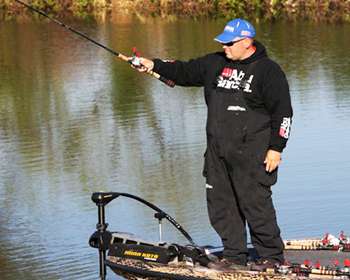
Bill Lowen has lots of experience trying to catch ultra-pressured bass. He was raised fishing the stingy Ohio River, where a limit is a rarity for many anglers, and a really heavy limit is a once-a-decade event.
So when the Elite Series tour goes to tough bodies of water, people look for Lowen to do well. Granted, low-weight tournaments are the exception rather than the norm, but he still implements the techniques he's learned whenever the bite gets tough. While others may shade toward finesse techniques in tough situations, "The Turtle," as he is known, is just as likely to go the other direction and employ baits that would look more at home on Falcon Lake, Amistad or Guntersville — the big stuff.
"Typically, I try to pay attention to what is going on around me," he says. "When everybody else is downsizing, I like to try something different."
Typically, this strategy works best when it's hot, "from the dog days of summer into the fall," he says. The magic water temperature is right around 80 degrees. "Think about it: When you're hot, sometimes it's easier to eat a big meal than a lot of little meals," he explains.
While a big crankbait, a large profile jig or a teeth-rattling spinnerbait might come into play, most of Lowen's warm weather upsizing extends to soft plastic baits. The fish may want something filling, but they don't necessarily want to chase it. Three of his favorites include the 10-inch Berkley Power Worm, a 5-inch Berkley Power Hawg and a Strike King Rage Craw (including the regular sized craw and the oversized "Lobster"). While those around him may be shaky head jigging or drop shotting, he brings out the big baits.
Lowen stays with the big flipping stick that he usually uses for these techniques, but he's exceptionally careful about his line choices — that's one area where he won't go bigger in most cases. "I usually start with 17- or 20-pound test," he said. "I typically don't go over 20 because it takes a lot of the action away from the bait."
He encourages anglers not to get discouraged if this contrarian approach fails to pay off immediately. "Sometimes in the early morning, the bass roam a lot," he says. "Then when the sun gets higher they become easier to catch. That high sun puts them on the wood." Put another way, you might want to try a technique that covers more water and then go to the big plastics when the fish hunker down in the thick stuff.
If it's a tournament situation, the adage about "looking for the right five bites" will more often prove to be true. While others struggle to put five 'swimmers' in the boat, the angler who goes against the grain, and stays true to big fish tactics, can often pull out the win. There's a time and a place for finesse, but don't think it's the only option.





